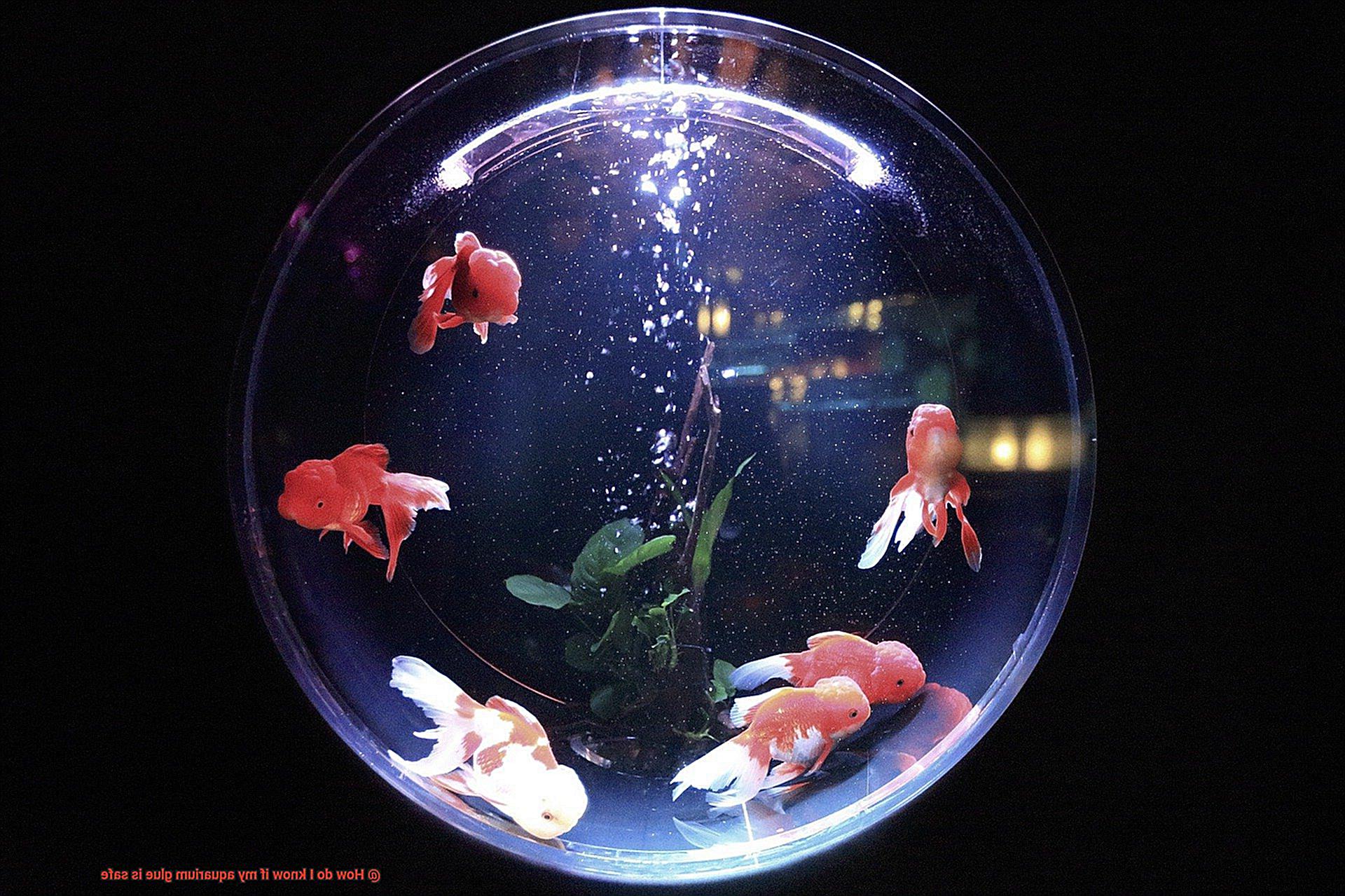Imagine a mesmerizing aquatic wonderland, teeming with vibrant corals, graceful fish, and lush plant life. An aquarium is not just a glass box; it’s a captivating slice of nature that brings tranquility and beauty into our homes. And behind the scenes, holding it all together, is the unsung hero of your underwater universe – aquarium glue.
But how can we be certain that the glue we use to construct our aquascapes is truly safe for our finned friends? With countless options and conflicting information out there, it’s crucial to dive deep into this subject and separate fact from fiction. Fear not, fellow aquarists. In this blog post, we’ll uncover the mysteries and shed light on how to determine if your aquarium glue is genuinely safe.
So strap in, soak up some casual expertise, and prepare to safeguard the wellbeing of your beloved aquatic inhabitants. Because when it comes to aquarium glue, safety reigns supreme.
What is Aquarium Glue?
Contents
- 1 What is Aquarium Glue?
- 2 How to Determine if Aquarium Glue is Safe
- 3 Avoiding Toxic Substances in Glue
- 4 Research and Read Reviews
- 5 Consulting with Experts
- 6 Conducting a Test Before Applying the Glue
- 7 Following Manufacturer Instructions When Applying the Glue
- 8 Regularly Monitoring the Aquarium After Using Glue
- 9 Conclusion
This specialized adhesive ensures that your aquatic environment remains leak-free and stable, providing a safe and secure habitat for your aquatic pets.
When choosing an aquarium glue, it is important to select one that is labeled as safe for use in aquariums and made from non-toxic materials. Regular glues or adhesives may not be suitable for underwater use, as they can dissolve or release harmful substances when exposed to water over time. To prevent any potential harm to your fish and other aquatic life, opt for a glue specifically designed for aquarium use.
There are different types of aquarium glues available, such as silicone-based and epoxy-based options. Silicone-based glues are commonly used for sealing joints and creating watertight bonds between glass panels. They offer excellent flexibility and resistance to water, making them ideal for constructing or repairing aquariums. On the other hand, epoxy-based glues are often used for bonding decorations or attaching plants to surfaces within the tank. These glues provide strong adhesion and are generally safe for use in aquariums.
When selecting an aquarium glue, carefully read the product label and follow the manufacturer’s instructions. This will ensure that you are using the glue correctly for your specific aquarium setup. Additionally, researching different brands and reading reviews can provide valuable insights into the performance and reliability of various aquarium glues.
To ensure the safety of your aquatic ecosystem, it is crucial to choose an aquarium glue that is explicitly labeled as aquarium-safe or fish-friendly. Reputable brands often mention this on their packaging or product descriptions, indicating that rigorous testing has been conducted to ensure the glue’s suitability for aquarium use. Avoid using glues that contain toxic substances like formaldehyde, lead, or other harmful chemicals.

Before applying any glue inside the aquarium, conduct a small test by applying a small amount of glue onto a non-porous surface like glass or plastic and submerging it in water for a few days. This test will help you observe any changes in water quality, such as cloudiness or unusual odor, which can indicate whether the glue is potentially unsafe for the aquarium environment.
When applying glue inside the aquarium, carefully follow the manufacturer’s instructions to ensure proper application. Using too much glue or applying it incorrectly can lead to excess curing time or improper bonding, which may compromise the safety and integrity of your aquarium.
Regularly monitor your aquarium after using glue for any signs of deterioration or changes in water quality. If you notice any concerns regarding the safety of the glue, it is best to remove and replace it with a known safe alternative.
How to Determine if Aquarium Glue is Safe
The safety of aquarium glue is paramount in maintaining the health and well-being of your fish and other aquatic life. Using the wrong glue can have detrimental effects on their delicate ecosystems. It is crucial to select a glue specifically designed for aquarium use.
Types of glue commonly used in aquariums:
Silicone adhesive and epoxy resin are two common types of glue that are safe for aquariums. These glues are specially formulated to be used underwater and are generally considered safe for aquarium applications.
Determining if a specific glue is safe:
To determine if a glue is safe for your aquarium, look for products that are labeled as “aquarium-safe” or “fish-friendly.” These labels indicate that the glue has undergone rigorous testing and has been approved for use in aquariums. Additionally, carefully inspect the ingredients list and avoid glues that contain harmful chemicals like formaldehyde and toluene.
Research and product reviews:
Before purchasing any aquarium glue, conduct thorough research and read product reviews. Online forums and dedicated fishkeeping websites can provide invaluable insights and recommendations from experienced aquarium hobbyists.
Seeking expert advice:
If you find yourself uncertain about which glue to use, seek advice from experts or professionals in the field. Local fish stores or aquarium specialists can offer guidance tailored to your specific tank setup, ensuring the safety of your aquatic inhabitants.
Following manufacturer’s instructions:
When using aquarium glue, it is crucial to meticulously follow the manufacturer’s instructions. Improper application or curing can lead to potential problems such as leaks or the release of harmful substances into the water. By adhering to the instructions, you can ensure the optimal performance and safety of the glue.
Avoiding Toxic Substances in Glue
In order to maintain a healthy and safe aquatic environment in your aquarium, it is crucial to avoid using glue that contains toxic substances. Harmful chemicals in glue can have detrimental effects on fish, plants, and other aquatic organisms, wreaking havoc on their well-being. To ensure that you are making the best choice for your aquarium, consider the following tips and considerations:
- Seek out aquarium-safe labels: When shopping for glue, look for products that are specifically labeled as “aquarium-safe” or “fish-friendly.” These labels indicate that the glue has been rigorously tested and deemed safe for use in aquatic environments. Choosing such glues will provide peace of mind and safeguard the health of your aquatic inhabitants.
- Steer clear of toxic chemicals: Take a close look at the label or product description to determine if any toxic substances are present. Be cautious of ingredients like formaldehyde, heavy metals (such as lead or mercury), or volatile organic compounds (VOCs). These chemicals can be extremely harmful to aquatic life, posing serious risks to their overall well-being.
- Consider underwater-specific formulations: Some glues are specifically formulated for underwater use, making them an excellent choice for aquarium applications. These glues are designed to withstand constant exposure to water without deteriorating or releasing any harmful substances. Opting for underwater-specific glues ensures that your repairs or attachments remain intact without compromising the health of your aquatic inhabitants.
- Read reviews from fellow hobbyists: Before making a purchase, take the time to read product reviews from other experienced aquarium hobbyists or professionals who have used the glue in question. Their firsthand experiences and recommendations can provide invaluable insights into the safety and effectiveness of different brands or products. Learning from others’ experiences can help you make an informed decision and avoid potential pitfalls.
- Seek expert advice when unsure: If you find yourself uncertain about which glue to choose, don’t hesitate to seek guidance from experienced aquarium hobbyists or professionals. These individuals possess a wealth of knowledge and can offer recommendations based on their own experiences. Consulting experts in the field will ensure that you make the best choice for your unique aquarium setup.
- Monitor water parameters and observe behavior: After applying the glue, it is essential to regularly monitor the water parameters in your aquarium, such as pH levels and ammonia levels. Additionally, closely observe the behavior and health of your aquatic inhabitants. Any adverse effects, such as changes in behavior or signs of distress, could indicate that the glue is causing harm. In such cases, it is crucial to remove the glue immediately to prevent further damage.
Research and Read Reviews
Researching and reading reviews is a critical task when it comes to ensuring the safety of aquarium glue. As a fish enthusiast, you want to be certain that the glue you use is safe for your aquatic friends. Fortunately, there are several ways to determine the safety of aquarium glue through thorough research and careful review reading.
One valuable resource is reputable sources such as aquarium forums, websites, and online communities. These platforms are filled with experienced hobbyists who willingly share their knowledge and experiences. Look for specific brands and products that come highly recommended by the community. Pay close attention to glue that is labeled as safe for use in aquariums or fish tanks, as this indicates that the product has undergone testing and meets safety standards.
Customer reviews on popular e-commerce websites like Amazon or Petco can also provide valuable insights. Look for products with a large number of positive reviews and high ratings. Take note of any recurring comments or concerns mentioned by customers, as these can give you important information about the glue’s safety and effectiveness.
Don’t forget to consult local fish stores or aquarium professionals for their recommendations. They have firsthand experience with various aquarium glues and can offer expert advice based on their knowledge and expertise. Professionals may also be able to provide information about specific brands or products that are commonly used and trusted in the industry.
As you conduct your research and read reviews, it’s crucial to be critical and discerning. Not all reviews may be reliable or unbiased, so look for patterns or consensus among different sources. Consider the credibility of the reviewer and whether they have any apparent biases or conflicts of interest.
Consulting with Experts
- Accurate and up-to-date information: Experts in the field stay informed about the latest research, advancements, and guidelines in the aquarium industry. They have their finger on the pulse of what’s safe and what’s not. When it comes to aquarium glue, they can provide accurate information about which types are specifically designed for aquarium use and have undergone rigorous testing to ensure their safety.
- Understanding potential risks: Experts can educate you about the potential risks associated with using unsafe glue in your aquarium. They can explain how certain glues may contain harmful chemicals or toxins that can leach into the water, posing a threat to the aquatic life residing in your tank. By understanding these risks, you can take appropriate measures to protect your pets.
- Personalized advice: Every aquarium is unique, with different dimensions, materials, and inhabitants. By consulting with an expert, you can receive personalized advice based on your specific situation. They can assess factors such as the type of materials you are bonding, the size of your tank, and the specific species of fish or plants in your aquarium to recommend suitable glue options that meet your specific needs.
- Recommendations based on experience: Experts have hands-on experience working with various types of aquarium glue. They have tried and tested different brands and products and can share their firsthand knowledge with you. Their recommendations can save you time and effort in researching different options on your own.
It is important to consult with experts who come in various forms, including aquarium store owners, professional aquarists, marine biologists, and experienced hobbyists. By seeking guidance from multiple sources, you can gather a range of opinions and perspectives to make a well-rounded and informed decision regarding the safety of your aquarium glue.
Conducting a Test Before Applying the Glue
Conducting a test before applying glue is crucial for several reasons. Here’s why it’s important:
- Safety: The well-being of your aquatic pets should always be a top priority. By conducting a test, you can ensure that the glue you are using is safe and non-toxic for your fish, invertebrates, and plants.
- Compatibility: Different glues may have varying levels of compatibility with different materials. Testing the glue on a small area allows you to determine if it adheres properly and does not cause any damage or discoloration to the surface.
- Adhesion: Testing the glue allows you to assess its bonding strength. This is especially important if you are using it to secure decorations, rocks, or other structures in your aquarium. You want to be confident that the glue will hold everything in place securely.
- Aesthetic Concerns: Applying glue to the wrong area or using a glue that causes discoloration can negatively impact the visual appeal of your aquarium. By testing the glue in an inconspicuous spot, you can avoid any potential aesthetic issues.
- Longevity: The durability of the glue is another factor to consider. By conducting a test, you can evaluate how well the glue holds up over time and if it remains intact even when exposed to water and other environmental factors.
- Prevention of Water Contamination: Some glues may release harmful chemicals or toxins into the water, which can be detrimental to your aquatic pets. Testing the glue beforehand allows you to identify any adverse reactions or changes in water quality.
To conduct a test before applying glue, follow these steps:
- Select a small area on the aquarium surface where you intend to apply the glue.
- Thoroughly clean the selected area using an aquarium-safe cleaner or warm water and mild soap.
- Apply a small amount of aquarium glue onto a piece of non-porous material, such as scrap glass or plastic.
- Spread the glue evenly over the test surface using a toothpick or a small brush.
- Allow the glue to cure for the recommended period mentioned in the product instructions.
- Examine the test surface for any adverse reactions caused by the glue, such as discoloration or deterioration of materials.
If the test results are satisfactory, proceed with caution by applying a small amount of glue to the designated area inside the aquarium. Always follow the manufacturer’s guidelines for curing time and any additional precautions specific to the glue you are using. It is also advisable to consult with experts or professionals in the field before making a final decision on which glue to use in your aquarium.
Following Manufacturer Instructions When Applying the Glue
Following manufacturer instructions when applying glue offers several benefits that contribute to the safety and effectiveness of the process. The product label contains crucial information that provides usage guidelines, safety precautions, and specific requirements for application. By reading and understanding this information, you can avoid mishaps and accidents.
Temperature and humidity levels play a significant role in the adhesive process. Some types of glue may not adhere properly if applied in extreme temperatures or high humidity conditions. Paying attention to the recommended application conditions mentioned on the label ensures a strong and secure bond.
Surface preparation is another critical aspect to consider. The manufacturer’s instructions may include specific requirements for cleaning or preparing the surfaces that need to be bonded. Following these instructions, such as removing existing adhesive residue or cleaning off grease and dirt, ensures optimal bonding.
Applying the right amount of glue is essential too. Over-application can lead to messy results or even potential harm to your aquatic environment. Following the recommended amount mentioned in the instructions helps avoid waste and risks.

Time and curing instructions are crucial elements of the process. Some glues require a specific amount of time to set and cure before being submerged in water. Failing to follow these instructions may result in a weak bond that could harm your aquatic life or cause leaks.
Lastly, safety precautions provided by the manufacturer should always be considered. This may include wearing protective gloves or goggles while applying the glue, as some adhesives may contain chemicals that can irritate your skin or eyes.
Regularly Monitoring the Aquarium After Using Glue
Regularly monitoring the aquarium after using glue is essential for ensuring the safety and well-being of your aquatic pets. When using glue in an aquarium, there are several potential consequences that can arise, including water contamination, deterioration of the adhesive bond, and harm to the aquarium inhabitants.
One of the first things to monitor after using glue in an aquarium is the water quality. Glue can release harmful substances into the water, such as toxins or chemicals that can affect the pH levels or introduce pollutants. It is important to regularly test the water parameters, including pH, ammonia, nitrate, and nitrite levels, to ensure they are within acceptable ranges for your aquatic pets.
Another aspect to monitor is the condition of the glued areas. Visual inspection should be conducted regularly to check for any signs of deterioration, such as cracks or peeling. If any damage is detected, it should be addressed promptly to prevent further issues or potential leaks.
In addition to visual inspection, observing the behavior of your aquatic pets is crucial. Changes in behavior, such as lethargy, loss of appetite, or increased aggression, could indicate that something is wrong with the aquarium environment. If these changes occur after using glue, it may be necessary to investigate whether the adhesive is causing any issues.
Leaks and seals should also be monitored closely. Over time, seals can weaken or break, leading to water leakage. Checking for any signs of leaks around areas where glue has been used, such as seams or joints, can help detect and address any issues before they worsen.
To prevent adverse effects from glue in the future, it is important to choose a glue specifically designed for aquarium use. There are various types of aquarium-safe glues available on the market, such as silicone adhesives or epoxy resins. It is crucial to follow the manufacturer’s instructions for application and curing times to ensure a strong and secure bond.
Regular maintenance procedures should also be implemented to prevent issues from arising. This includes regular water changes, cleaning of filters and other equipment, and removing any debris or algae growth. By maintaining a clean and well-maintained tank, you can minimize the chances of any adverse effects from the glue.
dMrqgq_JtdY” >
Conclusion
In conclusion, ensuring the safety of your aquarium glue is of utmost importance.
By following a few simple steps, you can have peace of mind knowing that your aquatic friends are in a secure environment. First and foremost, always check for labels and certifications indicating that the glue is specifically designed for aquarium use.
Look out for phrases like “aquarium-safe” or “non-toxic.” Additionally, do thorough research on the brand and read reviews from other fishkeepers who have used the product.
This will give you valuable insights into its reliability and safety record. Furthermore, consider consulting with experts at your local fish store or aquarium community to get their recommendations on trusted brands.
Remember to carefully follow the instructions provided by the manufacturer when applying the glue to ensure proper usage. Lastly, regularly monitor your aquarium for any signs of damage or deterioration in the glued areas.
If you notice any issues, take immediate action to rectify them before they pose a risk to your aquatic inhabitants.






